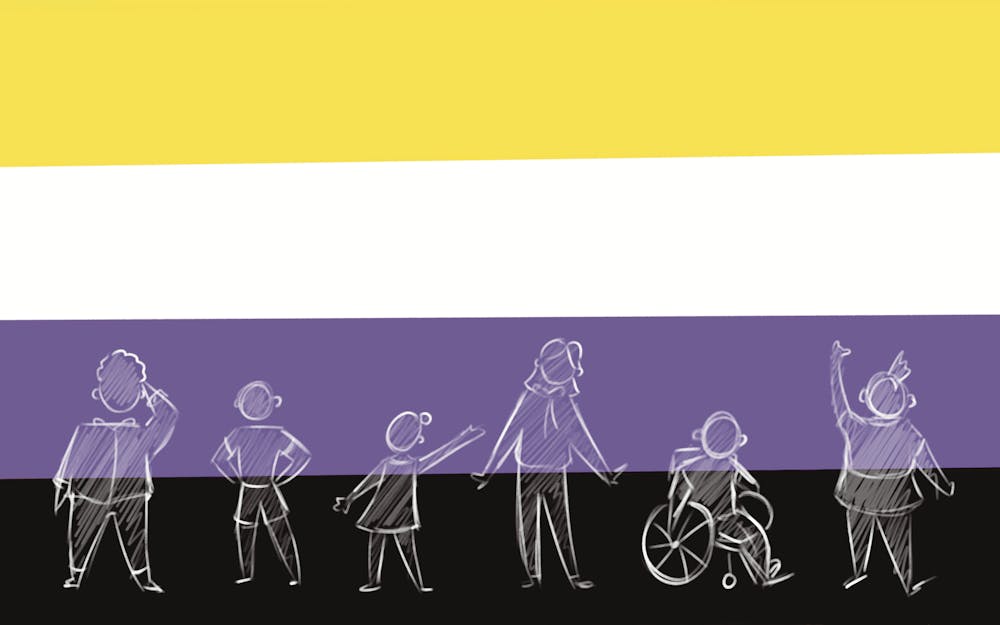I’ve lost count of the number of times I’ve been misgendered at IU.
It’s never been malicious, at least in my experience. It’s usually well-meaning classmates, instructors and peers who simply assume I use she/her pronouns. I even had an instructor write a recommendation letter for me using she/her. I cringed, but it was a PDF and I couldn’t do anything to fix it. So I just sent it in.
My first semester here, I got a message from a classmate apologizing for misgendering me in class. It was a discussion section, and I don’t even remember what they said. But their message stuck with me afterwards. It was one of the first times I had ever heard someone apologize for misgendering me; I only came out in college.
I’ve never corrected anyone on my pronouns, either. I don’t think I’ve ever said “uh, them” in response to a “her.” I can’t remember it if I have. I just stand there and pray that a friend next to me will correct them for me.
That’s never happened either.
The reason I can’t correct people is I understand why they see me as a woman. I have the face, voice, chest and legs of a woman. I have the demeanor and walk of a woman. I wear the clothes of a woman.
And yet I’m not a woman. I have to scratch and claw to not be seen as a woman. I can always dress more androgynously — whatever that means. I can always wear something to hide my chest and hips. I can always cut my hair a bit more. I can always try to stop my voice from peaking into a high-pitched register when I’m excited. I can always stop smiling and laughing and make myself more “manly” so people stop assuming who I am.
As of 2021, 94% of nonbinary adults have considered suicide. This statistic is for a myriad of reasons, but I’d bet that buildup has something to do with it. The little things that don’t necessarily feel like anything at first, but over time make you question yourself more and more. Should I just quit being myself and try to be what everyone else sees me as?
[Related: OPINION: Transphobia hurts us all]
The snowflakes that build to an avalanche.
In 2021, 1.2 million people –– 11% of the adult LGBTQ population –– identified as nonbinary. We’re not just a statistical aberration anymore. There’s more than likely a few nonbinary people sitting by you in class or in the dining hall or on the bus.
And yet I still can’t get gendered correctly on the first try.
There’s a certain nonbinary “look” that most people expect you to have to even consider dropping a “they.” It’s what I’d define as “soft masculinity:” short hair, flat chest, skinny waist and, probably most damningly, white.
How ironic that an identity specifically concerned with breaking gender norms has had a gender norm applied to it.
As of 2016, 55% of trans adults were white, 16% were Black, and 21% were Hispanic or Latino. The Eurocentric standard of gender makes it even more difficult for marginalized, gender nonconforming people to gain acceptance as members of their community. Oh, you don’t “look” nonbinary. Everyone knows we have to be waif-thin, vaguely masculine, vampire pale and stereotypically, Eurocentrically attractive.
The Western vision of gender itself is inherently racist. And no, that doesn’t mean that being a woman or a man makes you racist –– it means that our internalized values about what makes someone a woman or man are defined by racial stereotypes. Women are supposed to have soft features; if you have a flatter nose, thinner eyes or bumpier, darker skin (read: not white), you’re not as much of a woman. A binary view makes us police each other, and those who don’t shape up are seen as lesser.
Unfortunately, this white supremacist view has not spared a community that should be a bastion of free gender expression. No matter what we do, it’s nearly impossible to be free from a social structure that pervasive.
So, it comes down to you –– the individual.
First, stop assuming. I know this is difficult, because we’ve been trained to differentiate “boy” and “girl” since literally preschool. But when you meet someone new, please try to be considerate and don’t gender them until you’re sure of their pronouns –– even if they look incredibly masculine or feminine. I promise that it means a lot.
Stick up for your nonbinary friends. Yes, there is a time and place; some people aren’t out publicly. But if they are, just a few words privately to someone who is using the wrong pronouns can make the whole evening improve.
And, finally, please just listen to us. Don’t make excuses for misusing pronouns. Don’t justify yourself. Don’t let your ego stand in the way of being a kind, decent human and respecting us. If you’ve read this far, I know you can do it.
[Related: OPINION: Masculinity is an undefined word]
I can’t be that perfect vision of androgyny. I wish I didn’t have to be.
But if enough people lose that stereotype and start seeing us as the diverse group we are, maybe I’ll lose count of how many times I’ve heard my pronouns on the first try.
Danny William (they/them) is a sophomore studying cinematic arts.






